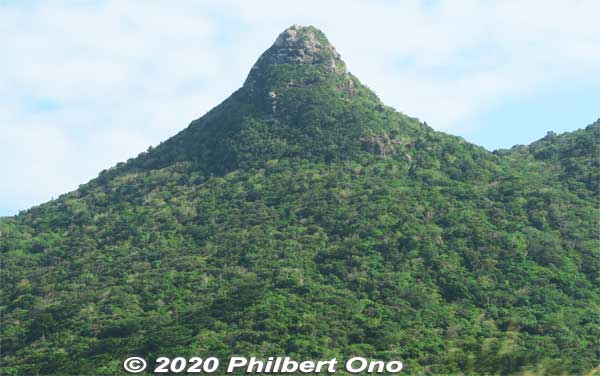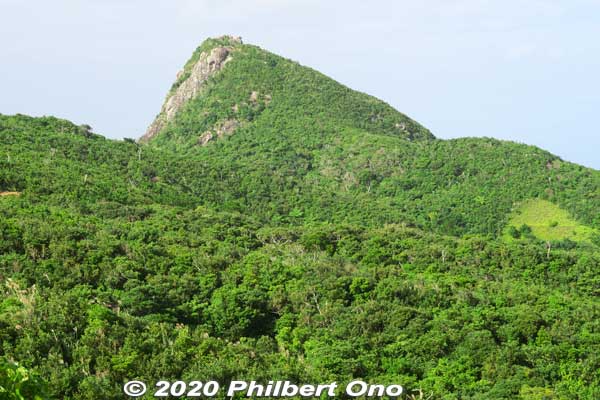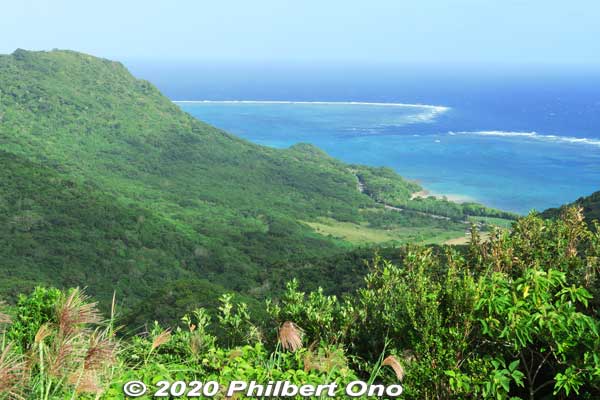by Philbert Ono
Updated: Jan. 6, 2020
Part of an article series on Yaeyama folklore in scenic Okinawa, Japan.
(八重山名勝の民話・民謡の英語訳シリーズ記事)

Mt. Nosokodake (野底岳), north of central Ishigaki, is Ishigaki’s second highest mountain at 282 m. Nicknamed Nosoko Maape (野底マーペー) in Japanese, Nusuku Maape (ヌスク マーペー) in the local dialect, and sometimes Nosoko-Fuji (野底富士).
Maape (pronounced Mah-pay, also spelled Mape) is the name of the girl in the famous local legend (story below) associated with the mountain.
From central Ishigaki, it’s about a 45-min. drive northward (via Route 39) to Nosokodake. You can drive up the mountain to the 200m elevation (free parking), then climb up the steep, narrow path taking about 15 min. to the summit. If you climb it, best to wear long pants, long sleeves, grippy gloves, sunglasses, and sneakers (no high heels or slippers). It’s a narrow trail in a thick temperate forest with trees, branches, exposed tree roots, rocks, bugs, etc., that can brush your skin. The steeper sections have ropes along the way you can grab. There’s also a longer trail starting at the foot of the mountain, taking 45 min. or so. Going with a local tour guide is recommended for first-timers.
The summit is a pointy tip with large rocks and beautiful 360˚ panoramic views. Don’t climb it on or after a rainy day. The trail will be muddy and slippery. An alternate plan would be to stop by the Nosoko-dake Scenic Point (野底岳展望台) nearby for fine views of the mountain and ocean.

Nosokodake is famous for a forlorn folk legend about a girl named Maape on nearby Kuroshima island (黒島) and her dear sweetheart Kanimui. The summit even has a wooden signboard telling the tale in Japanese. Since there seems to be no complete English version of this folk tale, I created one below based on Japanese versions. This sad love story, based on historical fact, was immortalized by two well-known folk songs titled, “Tsundara-bushi” and “Kubayama Koshiji-bushi” (つんだら節・久場山越路節) which I also explain with English lyrics below.
Nosoko Maape Folk Tale (野底マーペー伝承 英語訳)
Once upon a time, on the small, heart-shaped island of Kuroshima between Ishigaki and Iriomote in the Yaeyama Islands of the Ryukyu Kingdom (Okinawa), there was a pretty young girl named Maape and an energetic boy named Kanimui. They grew up together in the same village of Miyasato and became sweethearts. They were from farming families living right across each other along the island’s main road. They were always together when working and playing. All the villagers knew that they would someday get married.
However, one day, government officials from Shuri came to the island and told the islanders, “By the order of our King, you must produce more rice and sugar to pay government taxes. Since the farmland on this island is too small to produce more, half of you must move to Ishigaki and farm near Nosokodake.”
The government official then pointed to the main road in the middle of the island and declared, “People living on this side of the road must move to Ishigaki, and people on the other side of the road can remain on the island.”
Everyone was shocked and speechless, but they could do nothing against the sword-bearing government officials. Since Maape and Kanimui lived on the opposite sides of the road, they were going to be split up. Maape and her family had to move to Ishigaki, and Kanimui would stay behind on Kuroshima!
Kanimui burst into tears, fell to his knees, and begged, “PLEASE Honorable Sir, at least allow Maape to remain on this island. I promised to marry her someday!” However, no one listened to such an island peasant.
Kanimui and Maape said their sad goodbyes to each other. Their lives were changed forever by a road between their homes and an order from the government.
Residents from other nearby islands were also forced to move to Ishigaki. They started a new farming village called “Nosoko” between the ocean and Mt. Nosokodake. There were thick forests, so it was tough work to clear the land and farm all day. To make it easier, the farmers sang work songs while working.
Maape never forgot Kanimui and missed Kanimui dearly. She cried every night thinking about him. “My dear Kanimui, where are you and how are you?? I want to see you!!…”
One summer, malaria became an epidemic on Ishigaki and even Maape got sick. Even while sick in bed, she could only think about Kanimui.
When it was the village festival holiday, Maape wanted to at least see Kuroshima where Kanimui lived. So she left the house and climbed up Nosokodake even while sick. She reached the top of the mountain and looked all around for Kuroshima. “Hey, where’s Kuroshima??”
She saw the huge Mt. Omotodake blocking her view of Kuroshima. “Oh no!!! I can’t see Kuroshima!! I can’t see Kanimui!!” Omotodake is Ishigaki’s highest mountain.
Maape was heartbroken and fell to her knees on the summit. She wailed in sorrow all alone.
Since Maape failed to return home, a worried villager searched for her on Nosokodake and was astonished to find a rock crying and praying in the direction of Kuroshima. Maape had turned into stone on the top of Nosokodake!
Local villagers later nicknamed the mountain, “Nosoko-Maape” in her memory. This nickname is still commonly used today.
Translated into English by Philbert Ono from multiple sources.
This folk tale is based on a historical event. In 1732, the Ryukyuan government ordered people living on Kuroshima and Aragusuku islands to split up so that half the population would have to move to Ishigaki and start a new village near Nosokodake. About 400 people on Kuroshima were forced to move to Ishigaki. This resulted in relatives, sweethearts, etc., having to split up. It was to increase farming (and tax revenue) by making use of undeveloped lands.
Kuroshima already had enough people farming, and the Ryukyuan government wanted to increase the population in Ishigaki’s undeveloped Nosokodake area to farm and increase the island’s agricultural production. People could then pay more taxes in rice. The Ryukyuan Kingdom was motivated by the heavy per-head taxation imposed by the Satsuma Domain (Kagoshima) that controlled Ryukyu since 1609 when it invaded Ryukyu and made the kingdom a vassal state.
Such forced migrations occurred in the Yaeyama Islands repeatedly. Many people on Ishigaki are descendants of forced migrants who moved there in the centuries or decades past.
Kuroshima’s population was split in two using a traditional method called “michi-kiri” (道きりの法). At an intersection of two roads on the island, a government official let a standing pole fall to the ground by itself. People living on one side of the fallen pole would stay on the island, while people on the other side of the fallen pole would have to move to Ishigaki.
The moral of this folk tale might be a protest against the heavy taxation and forced migrations by the government. Not known who authored this tale.

Mt. Omoto-dake (於茂登岳) is Ishigaki and Okinawa Prefecture’s highest mountain and indeed blocks the direct line of sight between Nosokodake and Kuroshima. On the top of Nosokodake, there are some large rocks, and with some imagination, many people think that one of the perched rocks looks like Maape. Others say there’s no such rock. In Jan. 2018, one rock purported to be Maape was found to have fallen over. It’s still there lying on the summit.
Kuroshima is an inhabited island (pop. 226 as of March 2020) nearer to Iriomote. It’s somewhat heart-shaped and flat, being an outcrop of a coral reef. You can visit by high-speed boat from Ishigaki Port, taking about 30 min. The island is easy to tour by bicycle. The island has more cattle (thousands) than people. Kuroshima has also produced numerous local folk songs and dances like this one beautifully performed on the beach by Yaeyama High School students in Ishigaki(黒島保里村の芸能): https://youtu.be/PUobakzOhyg
Miyasato Village where Maape and Kanimui lived is on the western coast of Kuroshima facing Aragusuku Island. It’s hard to see which road divided the island in half and split up Maape and Kanimui.
The folktale doesn’t mention what happened to Kanimui, whether he married another girl or remained single in honor of Maape. I can only imagine that he married another girl because when you’re a farmer, you need a wife and lots of children to help out on the farm. Life goes on no matter what. I feel sorry about Maape though. Kanimui must have eventually found out what happened to her. I hope he later climbed Nokosodake and apologized to Maape’s crying stone.
Not sure if Maape and Kanimui actually ever existed, but their plight illustrates what very likely happened to many sweetheart couples in Yaeyama. The Nosoko farming village where Maape lived was eventually abolished in 1904 after a devastating tsunami and famine. The only remnant remaining is the Nusuku-on (野底御嶽) utaki sacred site in partial ruins. Today, there are people living in the Nosoko area.
Since 2003, people in Nosoko hold the annual Nosoko Tsundara Matsuri festival (野底つぃんだら祭り) in summer at Nosoko Elementary School. The outdoor festival features games for kids, stage entertainment, and people singing Tsundara-bushi on stage. People from Kuroshima also attend.



Two folk songs immortalized the Nosokodake folk legend about Maape and Kanimui:
“Tsundara-bushi” + “Kubayama Koshiji-bushi“
つんだら節・久場山越路節
In the Yaeyama dialect, Tsundara means both “beloved” (kawaii) and “pitifully sad” (kawaisou). It’s an apt title because “Tsundara-bushi” is about both love and sorrow. The song’s chorus “Tsundara yo” keeps repeating, “How beloved they are” or “How sad it is.”
“Tsundara-bushi” is sung from the viewpoint of Maape, telling her side of the story. However, it’s also okay for a male to sing the song. Or alternately between a male and female singer. I’ve also seen videos of this song being sung from Kanimui’s point of view by people on Kuroshima. On Kuroshima, the song is called “Chindara-bushi” in the local dialect.
Listen to the songs in the videos below. Yaeyama and Japanese lyrics are also displayed. Enjoy!
The second song “Kubayama Koshiji-bushi” is called the chirashi in Japanese music terminology. It’s a song complementing the first and sung seamlessly right after the first. It usually has a faster tempo. It sings about Maape’s sweet memories of her past life with Kanimui on Kuroshima. See my English translation of the lyrics below.
Tsundara-bushi (つんだら節 英語訳歌詞) *English translation by Philbert Ono. 1 さー とぅばらまーとぅばんとぅーや【ヨースーリ】 童からぬ遊びとら【つんだらつんだらよ】 かなしゃまとぅくりとぅや【ヨースーリ】 くゆさからぬむつりとら【つんだらつんだらよ】 Saa tubarama tubantu yaa [Yo suuri] Yarabi karanu asabi tora [Tsundara tsundara yo] Kanashama tukuri tuya [Yo suuri] Kuyusa kara nu mutsuri tora [Tsundara tsundara yo] You my dearest and I played together since childhood. You my dearest and I have been sweetheart friends since childhood. Chorus: Tsundara tsundara-yo! How beloved! (or How sad!) 2 さー 島とぅとぅみで思だら【ヨースーリ】 村とぅとぅみで思だら【つんだらつんだらよ】 沖縄からぬ御意志ぬ【ヨースーリ】 み御前からぬ御指図ぬ【つんだらつんだらよ】 Saa suma tutumi de umudara [Yo suuri] Hun tutumi de umudara [Tsundara tsundara yo] Uki na kara nu uisi nu [Yo suuri] Myoo mai kara nu usashi nu [Tsundara tsundara yo] We'll be together for as long as our island existed, I thought. We'll be together for as long as our village existed, I thought. But from the Ryukyu government came the King's decree. 3 さー 島別れでうはられ【ヨースーリ】 村別れでうはられ【つんだらつんだらよ】 うばたんがどぅけなり【ヨースーリ】 野底に別ぎられ【つんだらつんだらよ】 Saa suma bagari de uharare [Yo suuri] hunbagari de uharare [Tsundara tsundara yo] Ubatan ga duke nari [Yo suuri] Nusuku ni bagirare [Tsundara tsundara yo] The island was ordered to be split. The village was ordered to be split. I was the one to face much hardship, with me moving to Nosoko.
Kubayama Koshiji-bushi (久場山越路節 英語訳歌詞) 1 黒島にうるけや さふ島にうるけや【はりぬつぃんだらやう かぬしゃまやう】 Kurusuma ni uruke ya safusuma ni uru ke ya [Harinu tsundara yo, kanushama yo] When I was on Kuroshima, When I was on that island, Chorus: Harinu tsudara-yo kanushama-yo My dear guy, my dear girl! 2 島一つやりうり ふん一つやりうり【はりぬつぃんだらやう かぬしゃまやう】 Suma piti tsu yari uri hun piti tsu yari uri [Harinu tsundara yo, kanushama yo] The island used to be one. The village used to be one. 3 ぶなびしん我二人 ゆいふなぐん我二人【はりぬつぃんだらやう かぬしゃまやう】 Bunabi shin ba futaru yui funagun ba futaru [Harinu tsundara yo, kanushama yo] We were together when working in the fields. We were together when working in a yui. 4 山行きん我二人 いす下れん 我二人 【はりぬつぃんだらやう かぬしゃまやう】 Yama ikin ba futaru isu uren ba futaru [Harinu tsundara yo, kanushama yo] We were together when going to the mountains. We were together when going to the beach.
In “Kubayama Koshiji-bushi” Verse 3, yui was a small group of cooperative farmers who worked together on each other’s fields in turn. They probably sang work songs while working in the rice paddies.
Note:
- In song lyrics, Okinawan/Yaeyama words may be pronounced differently depending on the singer or dialect.
- Okinawan words can have nuances and connotations that cannot be expressed in Japanese nor in English. Inevitably, things will get lost in translation. Chorus expressions might also have no meaning or unknown meanings.
- English translations of the lyrics come from the Japanese translation of the Okinawan/Yaeyama lyrics. Both the standard Japanese and English translations are only approximate in meaning, intended to give you an idea of what the song is about.
- In the lyrics above, I didn’t include the Japanese translations because there are multiple versions or interpretations in Japanese by different people. There is no official Japanese translation.
- There are sounds in the Okinawan/Yaeyama language that cannot be precisely written in Japanese or English romanization. The Japanese and English romanization are only an approximation for such sounds.
References
https://okinawan.jp/minwa/minwa059.htm
http://rca.open.ed.jp/city-2000/minwa/story1.html
https://ameblo.jp/yamashiro-masatsugu/entry-10363874592.html
https://tabicoffret.com/article/77702/index.html
https://taru.ti-da.net/e1387126.html
https://taru.ti-da.net/e2476239.html
http://www.zephyr.justhpbs.jp/ishigakijima_utaki_2-2.html

Yaeyama Min’yo Overview | “Asadoya Yunta” | Yaeyama Stargazing | “Tinsagu nu Hana” | “Tsuki nu Kaisha” | “Tubara-ma” | Nosoko Maape | Kabira | Sakieda | Yaeyama Photos
